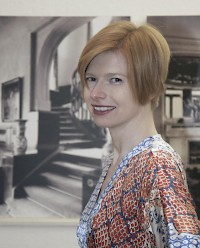Vita
Stefanie Klamm began her academic training with studies in history, classical archaeology, cultural studies, and philosophy at Humboldt University, Berlin and the University of Amsterdam. From 2006 to 2011 she completed a dissertation on the history of archaeological visualization in the 19th-20th century at the Max Planck Institute for the History of Science, Berlin and at Humboldt University, Berlin. She was also associated with eikones – NCCR (National Centre of Competence in Research) Iconic Criticism at Universität Basel, Switzerland and was a visiting scholar at the chair for science studies at the ETH Zurich in autumn 2007. In 2009 Stefanie Klamm received a stipend from the Gerda Henkel Foundation, and in the academic year 2009/10 she was a predoctoral fellow at the Getty Research Institute in Los Angeles. From 2010 to 2011 she was a fellow in the Cross Sectional Group “Cultural Theory and its Genealogies” at the Excellence Cluster “Topoi” (The Formation and Transformation of Space and Knowledge in Ancient Civilizations) at Humboldt University.
Stefanie Klamm’s research interests include the history of archaeology, the history of photography and drawing, as well as visualization practices in the sciences. She is also interested in the history of museums and collections and in the presentation of scientific knowledge in exhibitions. Since November 2011, Stefanie Klamm is a member of the Research Fellow Program “Tools of Drafting” at the IKKM.
Dated from 2012
IKKM Research project at the IKKM
Creating from Absence: The Archaeological Model as a Research Tool
How can images of past life evolve from mere traces of decayed material? The following project aims to analyze models of archaeological sites as the powerful actors they became at the end of the 19th century. Models of excavation sites, as the project will show, express archaeological methods, on which they reflect. At the same time, they are a three-dimensional conceptualization of the site. The focus of the research is on archaeological sites without significant structures in stone: the prehistoric settlements in northern Europe. These settlements are places that are particularly marked by the absence of the material past. Thus models of excavated prehistoric settlements are impressive sources for the simulation of the absent in particular, since they spatialize phenomena that are present only in traces and will be destroyed by digging. Only through media inscriptions can such phenomena be preserved. In this sense, models not only represent but create prehistoric settlement patterns. Their design and its related practices (drawing, photographing, sculpting with clay, constructing with wood, preparation of soil samples) could therefore exert extraordinary influence on the perception of the archaeological site.
Only in the absence of clear material remains did the model emerge, and with it experimental practices to create prehistoric dwellings and new ways of interpreting them. Models were able to combine the very complex details of excavation reports and simultaneously initiate a chain of different translations and references between two- and three-dimensional media. They have been powerful actors in the process of knowledge creation and the dispute over the interpretation of archaeological remains ever since.
These questions are relevant not only for the 19th century: the boom of virtual 3D models of ancient buildings, landscapes and settlements in archaeology allows references and comparisons with the present. In virtual models construction processes are often transformed into black boxes, which externalize their inherent assumptions. Hence, through the mere invisibility of their suppositions these models develop a strong momentum of their own. And yet virtual models of archaeological sites offer the depiction of vagueness, which can clarify different degrees of reconstruction. Thus they can represent uncertain knowledge, which will not be fixed, and remain experimental, while designing a past place.
Articles (selection)
Linie – Form – Raum: über wissenschaftliche Bilder antiker Skulpturen, in: Jörg Probst (Hg.), Reproduktion. Techniken und Ideen von der Antike bis heute, Berlin 2011, S. 138-155.
Ruinenwahrnehmungen, in: Ludger Derenthal, Christine Kühn (Hg.), Ein neuer Blick. Architekturfotografie aus den Staatlichen Museen zu Berlin, Tübingen, Berlin 2010 (Ausstellungskatalog, Museum für Fotografie Berlin), S. 18-21.
Neue Originale – Medienpluralität in der Klassischen Archäologie des 19. Jahrhunderts, in: Horst Bredekamp, Tatjana Bartsch, Marcus Becker, Charlotte Schreiter (Hg.), Das Originale der Kopie. Kopien als Produkte und Medien der Transformation von Antike, Berlin 2010, S. 47-67.
Sammeln – Anordnen – Herrichten: Vergleichendes Sehen in der Klassischen Archäologie, in: Lena Bader, Martin Gaier, Falk Wolf (Hg.), Vergleichendes Sehen, München 2010, S. 383-405.
Vom langen Leben der Bilder. Wahrnehmung der Skulptur und ihrer Reproduktionsverfahren in der Klassischen Archäologie des 19. Jahrhunderts, in: Pegasus – Berliner Beiträge zum Nachleben der Antike 9 (2007), S. 209-228.
Bilder im Wandel. Der Berliner Archäologie Reinhard Kekulé von Stradonitz und die Konkurrenz von Zeichnung und Fotografie, in: Jahrbuch der Berliner Museen 49 (2007), S. 115-126.
